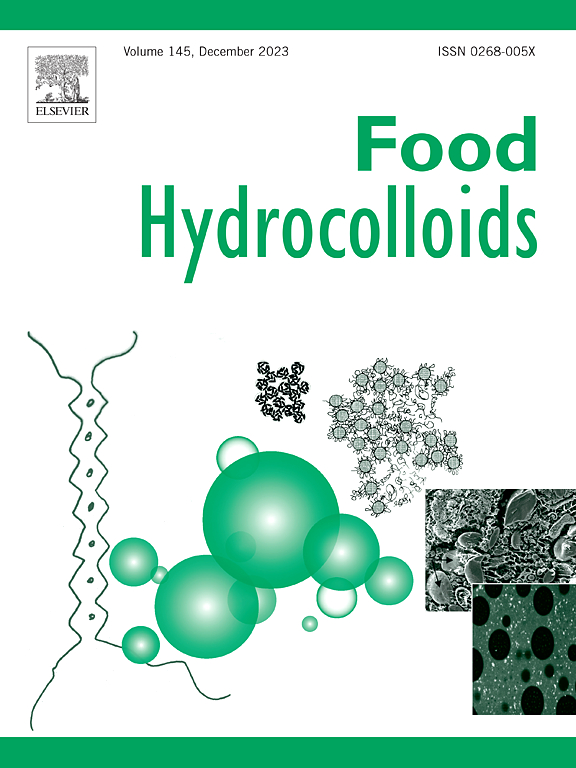Partially removing galactose unit on tamarind gum improves the gel-related features of tamarind gum/xanthan gels by strengthening their synergistic assembly
IF 11
1区 农林科学
Q1 CHEMISTRY, APPLIED
引用次数: 0
Abstract
The amalgamation of tamarind gum (TMG) and xanthan generates synergistic interaction gels (SIGs), which have been used to design novel textural systems and to develop cell-cultured meat as well as health foods tailored for elderly individuals with dysphagia. However, the strong aggregated tendency of TMG chains limited the expose of active sites, thereby hindering full binding with xanthan and resulting in suboptimal gel properties. This study demonstrated that the removal of galactose units from TMG enhances specific interactions between TMG and xanthan by modulating the aggregation behavior of TMG chains. After removing galactose to 71.30 %, the reduced steric hindrance facilitated the transformation of disordered TMG chains into a helical structure, thereby exposing more binding sites (i.e., hydrophilic groups) to interact with pyruvate groups on xanthan. This enhanced the specific interactions, as evidenced by an increase in enthalpy change from 2.80 × 10−2 J/g to 3.90 × 10−2 J/g, and thus the gel structure (suggested by the increased n and reduced values in Table 1) and gel strength both in G′ and gel hardness. However, further removal of galactose reduced the dissociation ability of TMG chains from clusters and resulted in the formation of elongated clusters, thereby decreasing the contact surface between TMG and xanthan, which weakened their specific interactions and gel strength. These results provide insights for the design and development of SIG-based systems in food industry.

部分去除罗望子胶上的半乳糖单元,通过增强罗望子胶/黄原胶的协同组装,改善了罗望子胶/黄原胶的凝胶相关特性
罗罗子胶(TMG)和黄原胶的混合产生协同相互作用凝胶(SIGs),已被用于设计新的质地系统和开发细胞培养肉以及为老年人量身定制的健康食品。然而,TMG链的强烈聚集倾向限制了活性位点的暴露,从而阻碍了与黄原胶的充分结合,导致凝胶性能不理想。该研究表明,通过调节TMG链的聚集行为,从TMG中去除半乳糖单元增强了TMG与黄原胶之间的特异性相互作用。将半乳糖去除至71.30%后,空间位阻的降低促进了无序的TMG链转化为螺旋结构,从而暴露出更多的结合位点(即亲水基团)与黄原胶上的丙酮酸基团相互作用。这增强了特定的相互作用,焓变从2.80 × 10−2 J/g增加到3.90 × 10−2 J/g,从而提高了凝胶结构(由表1中增加的n和减少的ξ链值表示)和凝胶强度(g′和凝胶硬度)。然而,进一步去除半乳糖降低了TMG链与簇的解离能力,导致簇的形成拉长,从而减少了TMG与黄原胶之间的接触面,从而削弱了它们的特异性相互作用和凝胶强度。这些结果为食品工业中基于sig的系统的设计和开发提供了见解。
本文章由计算机程序翻译,如有差异,请以英文原文为准。
求助全文
约1分钟内获得全文
求助全文
来源期刊

Food Hydrocolloids
工程技术-食品科技
CiteScore
19.90
自引率
14.00%
发文量
871
审稿时长
37 days
期刊介绍:
Food Hydrocolloids publishes original and innovative research focused on the characterization, functional properties, and applications of hydrocolloid materials used in food products. These hydrocolloids, defined as polysaccharides and proteins of commercial importance, are added to control aspects such as texture, stability, rheology, and sensory properties. The research's primary emphasis should be on the hydrocolloids themselves, with thorough descriptions of their source, nature, and physicochemical characteristics. Manuscripts are expected to clearly outline specific aims and objectives, include a fundamental discussion of research findings at the molecular level, and address the significance of the results. Studies on hydrocolloids in complex formulations should concentrate on their overall properties and mechanisms of action, while simple formulation development studies may not be considered for publication.
The main areas of interest are:
-Chemical and physicochemical characterisation
Thermal properties including glass transitions and conformational changes-
Rheological properties including viscosity, viscoelastic properties and gelation behaviour-
The influence on organoleptic properties-
Interfacial properties including stabilisation of dispersions, emulsions and foams-
Film forming properties with application to edible films and active packaging-
Encapsulation and controlled release of active compounds-
The influence on health including their role as dietary fibre-
Manipulation of hydrocolloid structure and functionality through chemical, biochemical and physical processes-
New hydrocolloids and hydrocolloid sources of commercial potential.
The Journal also publishes Review articles that provide an overview of the latest developments in topics of specific interest to researchers in this field of activity.
 求助内容:
求助内容: 应助结果提醒方式:
应助结果提醒方式:


